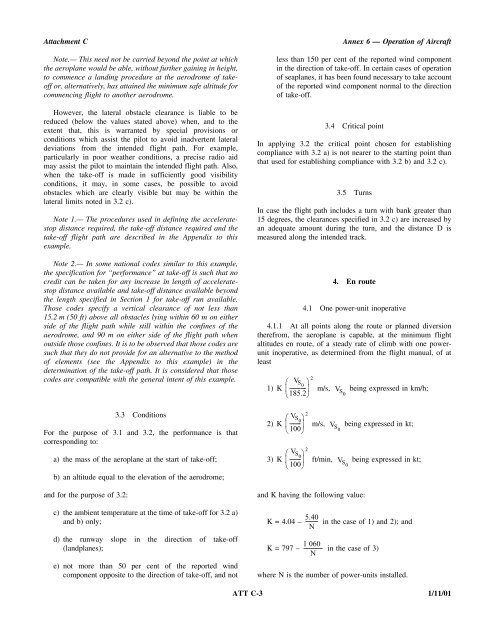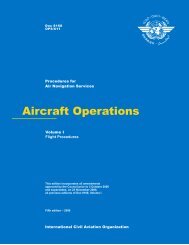Operation of Aircraft
Annex 6, Part I
Annex 6, Part I
- No tags were found...
Create successful ePaper yourself
Turn your PDF publications into a flip-book with our unique Google optimized e-Paper software.
Attachment C<br />
Note.— This need not be carried beyond the point at which<br />
the aeroplane would be able, without further gaining in height,<br />
to commence a landing procedure at the aerodrome <strong>of</strong> take<strong>of</strong>f<br />
or, alternatively, has attained the minimum safe altitude for<br />
commencing flight to another aerodrome.<br />
However, the lateral obstacle clearance is liable to be<br />
reduced (below the values stated above) when, and to the<br />
extent that, this is warranted by special provisions or<br />
conditions which assist the pilot to avoid inadvertent lateral<br />
deviations from the intended flight path. For example,<br />
particularly in poor weather conditions, a precise radio aid<br />
may assist the pilot to maintain the intended flight path. Also,<br />
when the take-<strong>of</strong>f is made in sufficiently good visibility<br />
conditions, it may, in some cases, be possible to avoid<br />
obstacles which are clearly visible but may be within the<br />
lateral limits noted in 3.2 c).<br />
Note 1.— The procedures used in defining the acceleratestop<br />
distance required, the take-<strong>of</strong>f distance required and the<br />
take-<strong>of</strong>f flight path are described in the Appendix to this<br />
example.<br />
Note 2.— In some national codes similar to this example,<br />
the specification for “performance” at take-<strong>of</strong>f is such that no<br />
credit can be taken for any increase in length <strong>of</strong> acceleratestop<br />
distance available and take-<strong>of</strong>f distance available beyond<br />
the length specified in Section 1 for take-<strong>of</strong>f run available.<br />
Those codes specify a vertical clearance <strong>of</strong> not less than<br />
15.2 m (50 ft) above all obstacles lying within 60 m on either<br />
side <strong>of</strong> the flight path while still within the confines <strong>of</strong> the<br />
aerodrome, and 90 m on either side <strong>of</strong> the flight path when<br />
outside those confines. It is to be observed that those codes are<br />
such that they do not provide for an alternative to the method<br />
<strong>of</strong> elements (see the Appendix to this example) in the<br />
determination <strong>of</strong> the take-<strong>of</strong>f path. It is considered that those<br />
codes are compatible with the general intent <strong>of</strong> this example.<br />
3.3 Conditions<br />
For the purpose <strong>of</strong> 3.1 and 3.2, the performance is that<br />
corresponding to:<br />
a) the mass <strong>of</strong> the aeroplane at the start <strong>of</strong> take-<strong>of</strong>f;<br />
b) an altitude equal to the elevation <strong>of</strong> the aerodrome;<br />
and for the purpose <strong>of</strong> 3.2:<br />
c) the ambient temperature at the time <strong>of</strong> take-<strong>of</strong>f for 3.2 a)<br />
and b) only;<br />
d) the runway slope in the direction <strong>of</strong> take-<strong>of</strong>f<br />
(landplanes);<br />
e) not more than 50 per cent <strong>of</strong> the reported wind<br />
component opposite to the direction <strong>of</strong> take-<strong>of</strong>f, and not<br />
Annex 6 — <strong>Operation</strong> <strong>of</strong> <strong>Aircraft</strong><br />
less than 150 per cent <strong>of</strong> the reported wind component<br />
in the direction <strong>of</strong> take-<strong>of</strong>f. In certain cases <strong>of</strong> operation<br />
<strong>of</strong> seaplanes, it has been found necessary to take account<br />
<strong>of</strong> the reported wind component normal to the direction<br />
<strong>of</strong> take-<strong>of</strong>f.<br />
3.4 Critical point<br />
In applying 3.2 the critical point chosen for establishing<br />
compliance with 3.2 a) is not nearer to the starting point than<br />
that used for establishing compliance with 3.2 b) and 3.2 c).<br />
3.5 Turns<br />
In case the flight path includes a turn with bank greater than<br />
15 degrees, the clearances specified in 3.2 c) are increased by<br />
an adequate amount during the turn, and the distance D is<br />
measured along the intended track.<br />
4. En route<br />
4.1 One power-unit inoperative<br />
4.1.1 At all points along the route or planned diversion<br />
therefrom, the aeroplane is capable, at the minimum flight<br />
altitudes en route, <strong>of</strong> a steady rate <strong>of</strong> climb with one powerunit<br />
inoperative, as determined from the flight manual, <strong>of</strong> at<br />
least<br />
V S0<br />
⎛ ⎞ 2<br />
1) K ⎜------------<br />
⎟ m/s, V being expressed in km/h;<br />
⎝185.2<br />
S0<br />
⎠<br />
V S0<br />
⎛ ⎞ 2<br />
2) K ⎜--------<br />
⎟ m/s, V being expressed in kt;<br />
⎝100<br />
S0<br />
⎠<br />
V S0<br />
⎛ ⎞ 2<br />
3) K ⎜--------<br />
⎟ ft/min, V being expressed in kt;<br />
⎝100<br />
S0<br />
⎠<br />
and K having the following value:<br />
K = 4.04 –<br />
5.40<br />
---------<br />
N<br />
in the case <strong>of</strong> 1) and 2); and<br />
1 060<br />
K = 797 – -------------- in the case <strong>of</strong> 3)<br />
N<br />
where N is the number <strong>of</strong> power-units installed.<br />
ATT C-3 1/11/01












